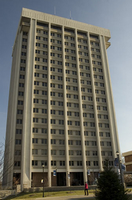Two weeks ago, the Patterson School of Diplomacy and International Commerce graduated its 50th class. Having completed not only an 18-month program of study but also a gamut of comprehensive exams, the roughly 30 graduating students are now ready to enter the foreign-policy workforce. But the Patterson School is just one element of an archipelago of schools focusing on international policy that collectively helps staff the Foreign Service, the intelligence community, a variety of non-governmental organizations, and corporations with international divisions.
Other schools with the same mission include the Elliot School of International Affairs at George Washington, the Walsh School of Foreign Service at Georgetown, the Fletcher School of Law and Diplomacy at Tufts, the Nitze School of Advanced International Studies at Johns Hopkins, the Kennedy School of Government at Harvard, and many others. Some, although not all, of these schools have doctoral programs in addition to offering master's degrees, and some also offer undergraduate majors.
Each of these schools has a unique history. The Patterson School was founded in 1959 on the strength of a grant made in 1922. The Elliot School came into existence in 1898 as the School of Comparative Jurisprudence and Diplomacy. The Walsh School was founded in 1919, the Fletcher School in 1933, the Kennedy School in 1936, and SAIS in 1943. The growth in size and number of such programs runs parallel with the expansion of the U.S. college and university system in the 20th century, but also with the dramatic increase in the size and professionalism of the country's foreign-policy apparatus. As America's responsibilities and interests abroad have grown, the institutions providing the personnel who help make U.S. foreign policy function have responded.

